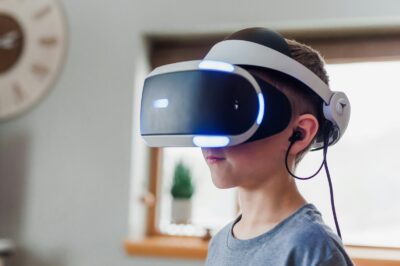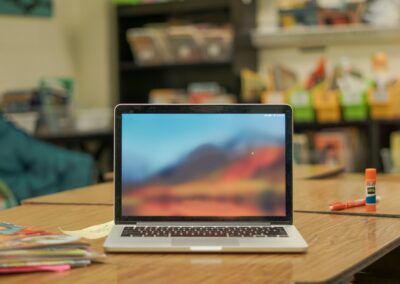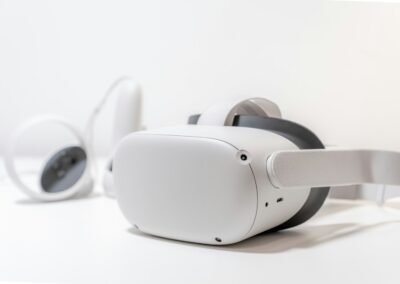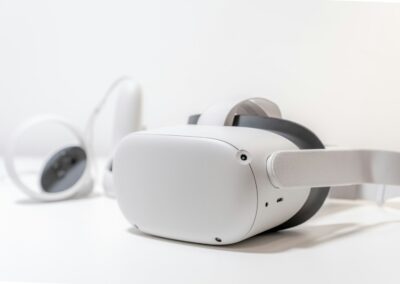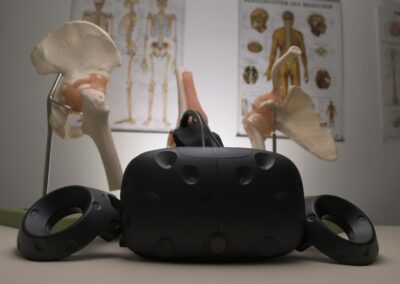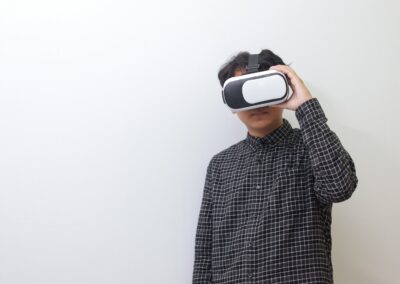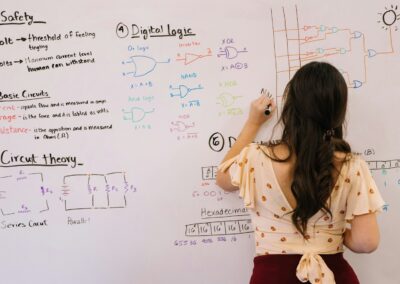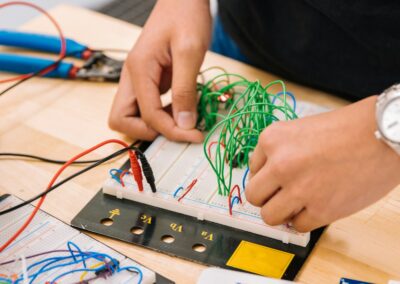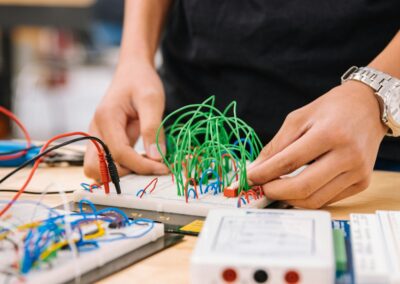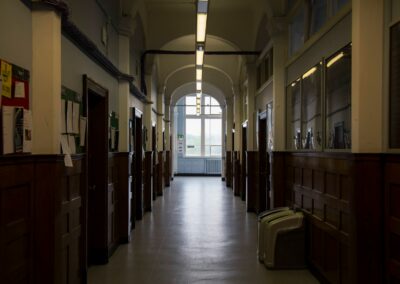Transforming Education through Virtual Classrooms and Laboratories
The Role of Technology in Immersive Learning Environments
Immersive learning environments with virtual classrooms and laboratories have the potential to revolutionize education by providing interactive and engaging experiences for students. The creation of these environments relies heavily on cutting-edge technologies, including virtual reality (VR), augmented reality (AR), artificial intelligence (AI), and the Metaverse. These technologies enable the development of virtual spaces where students can explore, experiment, and collaborate in ways that traditional classrooms cannot offer.
Virtual classrooms and laboratories leverage VR and AR to create realistic simulations of real-world environments. For instance, medical students can practice surgical procedures in a virtual operating room, while engineering students can design and test structures in a simulated environment. This hands-on experience is invaluable for developing practical skills and understanding complex concepts. In regions like Saudi Arabia and the UAE, where educational innovation is a priority, the adoption of immersive learning technologies can significantly enhance the quality of education and better prepare students for the future.
AI plays a crucial role in personalizing the learning experience within these virtual environments. AI algorithms can analyze student performance data to identify strengths and weaknesses, providing tailored feedback and adaptive learning paths. This personalized approach ensures that each student receives the support they need to succeed, fostering a more inclusive and effective learning environment. By integrating AI with virtual classrooms and laboratories, educational institutions in Riyadh and Dubai can offer a more customized and impactful learning experience.
Implementing Virtual Classrooms and Laboratories
The implementation of virtual classrooms and laboratories requires a comprehensive approach that involves investment in technology, training for educators, and the development of appropriate content. Educational institutions must first invest in VR and AR hardware, such as headsets and motion controllers, as well as software platforms that support the creation and delivery of immersive content. Additionally, robust IT infrastructure is essential to ensure smooth operation and access to these virtual environments.
Training educators to effectively use these technologies is another critical component. Teachers need to be proficient in operating VR and AR equipment, as well as integrating these tools into their lesson plans. Professional development programs and workshops can help educators become comfortable with the technology and learn best practices for creating engaging and interactive lessons. In Saudi Arabia and the UAE, where there is a strong focus on teacher development, investing in training can help maximize the benefits of virtual classrooms and laboratories.
Developing high-quality content is also essential for the success of immersive learning environments. Educational institutions should collaborate with content creators and subject matter experts to design virtual experiences that are both educational and engaging. These experiences should align with curriculum standards and learning objectives, ensuring that students gain the knowledge and skills they need to succeed. By prioritizing content development, institutions in Riyadh and Dubai can create immersive learning environments that enhance student outcomes and drive educational innovation.
Leadership and Management in Educational Transformation
Effective leadership and management are crucial for navigating the transformation to immersive learning environments. Leaders in educational institutions must be visionary and strategic, recognizing the potential of virtual classrooms and laboratories to enhance learning outcomes. They must also be proactive in addressing the challenges associated with implementing these technologies, such as securing funding, managing resistance to change, and ensuring equitable access for all students.
Strategic planning is essential for successfully integrating virtual classrooms and laboratories into the educational framework. Leaders should develop comprehensive plans that outline the steps needed to implement the technology, including budgeting, resource allocation, and timelines. By setting clear goals and milestones, leaders can ensure that the transition to immersive learning environments is well-organized and effective. In Saudi Arabia and the UAE, where strategic initiatives in education are already in place, integrating immersive learning technologies can further enhance these efforts.
Collaboration and communication are also key to successful implementation. Leaders must engage with stakeholders, including educators, students, parents, and policymakers, to build support for immersive learning initiatives. By fostering a collaborative environment, leaders can ensure that all stakeholders are aligned with the strategic vision and committed to the success of the initiative. Involving stakeholders in the planning and implementation process can also help address concerns and identify solutions to potential challenges, ensuring a smoother transition to virtual classrooms and laboratories.
Strategic Implications of Immersive Learning Environments for the Middle East
Driving Educational Innovation in Saudi Arabia and UAE
Saudi Arabia and the UAE are well-positioned to lead the charge in educational innovation, with immersive learning environments playing a central role in this transformation. These nations have made significant investments in advanced technologies and are committed to creating environments conducive to innovation. By embracing virtual classrooms and laboratories, Saudi Arabia and the UAE can enhance their educational systems and prepare students for the demands of the modern workforce.
In Riyadh, initiatives such as the National Transformation Program and Vision 2030 highlight the country’s commitment to technological advancement and educational excellence. Integrating immersive learning environments aligns perfectly with these goals, offering a pathway to developing new educational models and creating high-tech learning experiences. By leveraging VR, AR, AI, and the Metaverse, Riyadh can attract global talent and investment, solidifying its position as a hub of educational innovation.
Similarly, Dubai’s futuristic vision and ambitious projects make it an ideal candidate for the adoption of immersive learning environments. The Dubai Future Foundation and other forward-thinking organizations are already exploring the potential of these technologies. By implementing virtual classrooms and laboratories, Dubai can enhance its educational offerings and drive economic growth, positioning itself as a global leader in educational innovation.
Integrating AI and Blockchain in Immersive Learning
The intersection of immersive learning with AI and blockchain presents exciting possibilities for educational advancement and business innovation. These technologies, when combined, can create powerful synergies that drive unprecedented levels of efficiency, security, and functionality. For educational institutions in Saudi Arabia and the UAE, this convergence offers a unique opportunity to stay ahead of the curve and maintain a competitive edge in the global education market.
AI can significantly enhance the capabilities of immersive learning environments by providing advanced algorithms and machine learning techniques to optimize educational processes. This integration can lead to more intelligent and adaptive systems, capable of handling complex tasks with greater precision and speed. For example, AI-powered virtual classrooms can provide real-time feedback and personalized learning paths, enabling students to learn at their own pace and according to their individual needs.
Blockchain technology, known for its robust security features, can complement immersive learning by providing secure and transparent frameworks for data transactions. This combination can be particularly beneficial in sectors such as education, where data integrity and security are paramount. By leveraging blockchain-enabled immersive learning environments, educational institutions can ensure the reliability and confidentiality of student data, fostering trust and confidence among stakeholders.
Embracing the Metaverse and Generative AI in Education
The Metaverse and generative artificial intelligence (AI) are two emerging trends that hold immense potential when integrated with immersive learning environments. The Metaverse, a virtual universe that combines augmented reality (AR), virtual reality (VR), and the internet, offers new opportunities for immersive educational experiences and digital interactions. By incorporating the Metaverse, immersive learning environments can achieve greater computational power and efficiency, enhancing the realism and interactivity of virtual classrooms and laboratories.
In Saudi Arabia and the UAE, the adoption of the Metaverse can drive innovation in various educational sectors, including higher education, vocational training, and K-12 education. For instance, educational institutions can create virtual campuses and immersive learning experiences, offering students a new way to engage with content and collaborate with peers. This can enhance the learning experience and provide students with the skills and knowledge they need to succeed in the modern workforce.
Generative AI, which involves using AI to generate new content and ideas, can also benefit from the integration of immersive learning environments. This combination can lead to more sophisticated generative models, capable of producing high-quality educational content in real time. For educational institutions, this means the ability to create personalized learning materials, develop innovative teaching methods, and streamline content creation processes. The synergy between immersive learning environments, the Metaverse, and generative AI represents a new frontier in educational innovation, with vast potential for business growth and success in Saudi Arabia and the UAE.
Conclusion
In conclusion, the creation of immersive learning environments with virtual classrooms and laboratories holds immense potential to revolutionize education. For educational institutions in Saudi Arabia and the UAE, embracing this advanced technology can drive educational innovation, enhance student outcomes, and foster a culture of continuous learning. By integrating immersive learning with other emerging technologies such as artificial intelligence, blockchain, and the Metaverse, these nations can position themselves as global leaders in educational advancement and business success. The journey towards this future requires strategic investments, effective leadership, and a commitment to continuous learning and adaptation, ensuring that the full potential of immersive learning environments is realized.
#ImmersiveLearning #VirtualClassrooms #VirtualLaboratories #EducationInnovation #SaudiArabia #UAE #ArtificialIntelligence #Blockchain #Metaverse #GenerativeAI #Riyadh #Dubai #EducationalSuccess #LeadershipSkills #ProjectManagement


